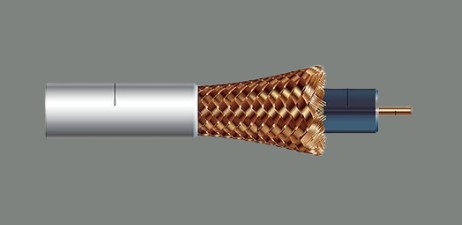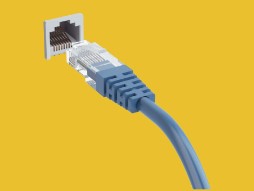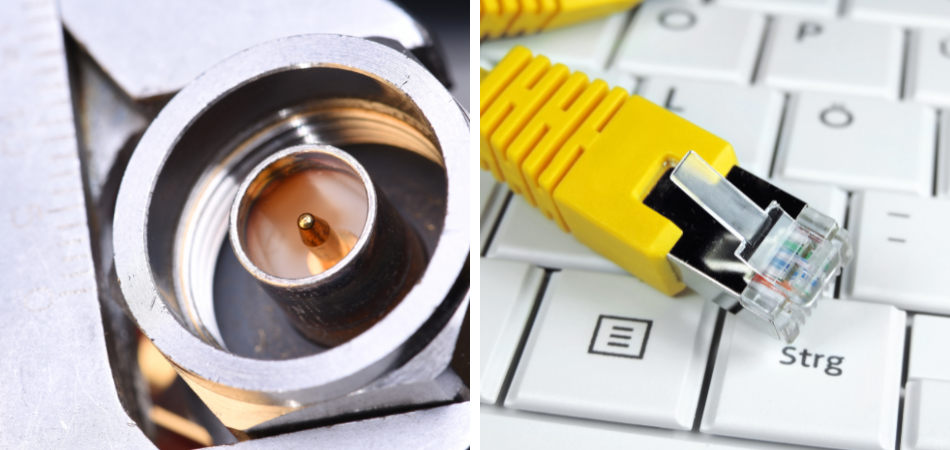If you have a small office or work-from-home set up in your house, you’ve probably had to decide whether to run cable for upgraded productivity. And when it comes to running cable, you mainly have two options: coaxial or Ethernet. Both are wired technologies commonly used in networking.
But which one should you use? Both have advantages and disadvantages, but the key difference lies in their functioning. While Ethernet cables are used for computer networking and digital signal transmission, Coaxial cables are mainly used for analog and data-heavy long-distance transmissions.
In this article, we’ll take a more detailed look at the difference between coaxial and Ethernet cables, including how they work, their purposes, and which might be right for your needs.
Coax Vs Ethernet – Comparison Chart
In case you are in a rush, here is a nifty table on the coax and ethernet comparison. But we suggest you read the entire article for a clear and better understanding.
| Factors | Coax | Ethernet |
| Function | Analog and video signal transmission | Computer networking and digital signal transmission |
| Jacketing | Two conductors are protected by a braided aluminum shield with an insulator between them | Shielded and unshielded twisted pairs with PVC jacketing |
| Type of Connections | Audio and video devices | Local area networking and digital data transfer |
| Bandwidth | 1 GHz and up | Limited to 100 MHz |
| Speed | Limited to 1 Gbps | 10 Gbps or more |
| EMI/RFI Interference | More resistant | Comparatively less resistant |
| Security | Uses different non-standard protocols for internet transmission | Uses standardized TCP/IP protocols for internet transmission |
| Long-Distance Performance | More capable than Ethernet | Relatively less capable than Coaxial |
| Cost | More expensive | Less expensive |
What Is Coax?
Coax is a physical transmission medium that uses electromagnetic waves to transmit signals from one point to another. They have long been the standard for transmitting analog signals over long distances because of their reliability.

They’re also easy to install, which is why you’ll find them in many homes and commercial buildings such as office buildings, schools, and hospitals. And although they’re most commonly used for video and heavier signals alike, Coax can also transmit electrical power and the internet.
There are two types of coaxial cables: thick-wire and thin-wire designs. The thick-wire design has a solid center conductor made of copper or aluminum with a wrapped-around braided shield. The thin-wire design has a solid center conductor surrounded by a braided shield with an insulator (foam or plastic) between them.
Both designs use an outer jacket to protect the inner parts from damage during installation or use. The thicker the shield, the better protection it offers against EMI — for example, less noise on your TV picture.
What Is Ethernet?
Ethernet is a family of computer networking technologies that include local area network (LAN) standards, WAN (wide area network) standards, and MAN (metropolitan area network) standards. The Institute of Electrical and Electronics Engineers (IEEE) was responsible for developing Ethernet standards.

These cables are the standard for connecting computers, printers, and other devices on a LAN. They come in various types and sizes, the most common being Cat 5, Cat 6, and Cat 7.
Ethernet cables are made of four twisted pairs of copper wire that are each wrapped in an individual insulating jacket. The pairs are then twisted together and wrapped in an outer jacket. Electromagnetic interference (EMI) from other cables or devices is eliminated by twisting the pairs.
Although Ethernet is known for connecting WiFi routers or modems to internet-ready devices, it can also be used to connect two devices without an internet connection. This is why data centers use them as the primary connection type.
Coax Vs Ethernet: What Are The Differences?
The functional discrepancy is undoubtedly the major distinction between coaxial and Ethernet cables. Yet, several other factors set these two types of cables apart. Let’s take a more detailed look at each.

1. Jacketing
Coaxial cables consist of two conductors, with a solid center surrounded by a braided aluminum shield with an insulator between them. On the other hand, Ethernet cables use shielded and unshielded twisted pairs to minimize interference and crosstalk.
The type of jacketing affects the overall durability of the cable. Coaxial cables are more durable than Ethernet cables because the solid center conductor can’t be damaged as easily. The braided aluminum shield also protects the inner parts from damage.
Comparatively, Ethernet cables are somewhat less durable because the twisted pairs can become untwisted by pulling on the cable, increasing the possibilities of interference. The outer PVC jacket also offers less protection than the braided aluminum shield.
2. Type of Connections and Carried Data
Primarily, coaxial cables are used to carry video and analog signals, while Ethernet cables are used to carry internet data.
Coaxial cables are primarily used to connect audio and video devices, such as TV, CD, and DVD players, turntables and cassette players, DVRs, and Blu-ray players.
Additionally, they can connect certain types of computer equipment, including older generation modems and printers. Besides, MoCA (Multimedia over Coax Alliance) cables can connect to the internet.
Contrastingly, Ethernet cables connect computers, printers, and other devices on a LAN besides connecting to the internet. They can also connect two devices without an internet connection for digital data transfer. However, Ethernet cannot transmit voice and video signals in real-time (streaming) without the internet as Coax does.
3. Bandwidth
The bandwidth is the range of frequencies that a cable can carry. In other words, it’s the amount of data transmission capacity available. Coaxial cables have a higher bandwidth than Ethernet cables. This means they can carry more data over longer distances without losing signal quality.
Coaxial cables can carry frequencies up to several GHz, while Ethernet cables are limited to 100 MHz. The higher bandwidth of coaxial cables makes them ideal for promptly carrying massive amounts of data, such as HD video and audio, over long distances.
Ethernet cables are better suited for carrying smaller data volumes, such as internet packets. They can also be used to connect devices that don’t require high-speed data transfer, such as printers and scanners.
4. Speed
Although Coaxial has a higher bandwidth than Ethernet, the latter is the clear winner regarding speed. The latest versions of Ethernet can transmit data at speeds of 10 Gbps (gigabits per second) or more, while coaxial cable can only transmit data at a maximum speed of 1Gbps.
This is because Ethernet cables use twisted pairs to reduce crosstalk and interference, while coaxial cables do not. Twisted pairs also transfer data faster because of lower latency, the time it takes for a signal to travel from one point to another.
The higher bandwidth of Ethernet means it’s better suited for multi-channel digital audio and video content like HDTV unless Ethernet splitters reduce speed. Coaxial cable is limited to one channel, so it’s not as good for transmitting multiple channels of high-definition content.
5. EMI/RFI Interference
EMI/RFI interference is caused by any device that produces unwanted electromagnetic energy, mainly in the form of radio frequency signals, which results in degradation or disruption of other electronic devices within the same environment.
The interference resistance of Ethernet and coax greatly differ. While Ethernet cables can be affected by electromagnetic interference (EMI) and radio frequency interference (RFI), coaxial cables are less susceptible to these issues.
This is because Ethernet cables are more susceptible to electromagnetic fields (EMFs) than coaxial cables. When an electromagnetic field passes through an Ethernet cable, it can cause data corruption or damage the network card on your computer.
Coaxial cables, on the other hand, are better at resisting EMFs because they contain a dielectric layer between two conductive layers. This means they don’t conduct electricity as well as copper wire, which means they’re less likely to transmit electrical signals to nearby computers and devices.
6. Security
Ethernet uses TCP/IP (Transmission Control Protocol/Internet Protocol) to send packets of information over its network. This protocol is standardized across all Ethernet networks and makes it easy to communicate with another computer or router on an Ethernet network.
Coax networks use different transmission protocols, such as QAM (Quadrature Amplitude Modulation) or QPSK (Quadrature Phase Shift Keying), which aren’t as standardized as TCP/IP.
This means that when you try to connect one node on a coax network to another node on another coax network, you might have trouble communicating with each other if they’re using different transmission protocols.
Ethernet also uses MAC (Media Access Control) addresses to identify devices on its network. MAC addresses are unique to each device, so it’s hard for someone to spoof a MAC address and gain access to your Ethernet network.
Coaxial networks don’t use MAC addresses. Instead, they use IP addresses, which aren’t as secure. This is because IP addresses can be spoofed more easily than MAC addresses.
7. Long-Distance Performance
Coaxial cable may not be as fast as Ethernet, but it can reach longer distances. Coaxial cable was once the standard way of delivering high-speed Internet to homes and businesses. Nowadays, it’s mostly used by cable TV services, but some ISPs still use it to deliver Internet access to remote locations where DSL and fiber aren’t available.
Coaxial cable can reach longer distances because it has a lower attenuation rate than Ethernet. Attenuation is the loss of signal strength over distance. The higher the attenuation rate, the shorter the maximum distance the signal can travel. Since coaxial cable uses higher frequencies, its attenuation rate is lower than Ethernet. This means the signal can travel further before it starts to degrade.
8. Cost
Coaxial cables are more expensive than Ethernet cables. This is because they’re made of more expensive materials like copper and gold and require more advanced manufacturing techniques.
Ethernet cables are less expensive because they’re made of cheaper materials like plastic and aluminum and are easier to install. They also don’t require expensive connectors or terminators, reducing their cost further.
Coaxial cables are also more difficult to troubleshoot than Ethernet cables. This is because they use various transmission protocols, which can make it difficult to identify the source of the problem, adding to the repair cost.
In contrast, Ethernet cables are easier to troubleshoot because they use the same transmission protocol, making identifying the source of the problem easier.
Conclusion
Hopefully, our comparative take on Coax Vs Ethernet has helped you understand the difference between the two types of cables. While both works great in their own ways, Ethernet is typically the better choice for most modern-day applications. It’s versatile, faster, more reliable, and easier to troubleshoot.
However, if you still need to use coaxial cables for some reason, like setting up long-distance networks, or video-oriented applications, then you must go ahead and use them by all means. And when you need to combine both, you can always go for Ethernet over Coaxial cables for the best of both worlds.
